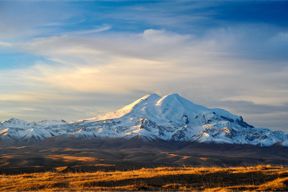Mount Ramiel
| Mount Lenthir | |
|---|---|
| Mount Gamilami, Mount Voilith | |
 Mount Lenthir, as seen from the Lenthiri highlands | |
| Highest point | |
| Elevation | 5,480 m (17,980 ft) |
| Prominence | 5,480 m (17,980 ft) |
| Parent peak | Béváse'jérna |
| Listing | Highest peak in Lugida Ultra-prominent peaks |
| Coordinates | 31°33'23"N, 0°27'02"E |
| Naming | |
| Translation | "Gate" (Lithian) |
| Geography | |
| Location | Lenthir Prefecture, Lugida |
| Parent range | Rietic Mountains |
| Geology | |
| Mountain type | Stratovolcano (dormant) |
Mount Lenthir (Lithian: Gedra Lenthir [gedɾa lentʰiɾ]), also referred to as Mount Gamilami, is the highest mountain in Lugida. At 5,480 metres (17,980 ft) above sea level, it is Lugida's only five-thousander as well as the only four-thousander other than the neighboring Mount Haiwa, whose peak reaches 4,306 metres (14,127 ft) above sea level. Mount Lenthir comprises the southernmost edge of the Rietic Mountains. The summit lies 100 kilometres (62 mi) southwest of Natlia and 40 kilometres (25 mi) from the nearest shoreline to the south, towards Dodre Bay and the Gulf of Sharkunen.
The mountain plays a central role in Lenthirite mythology, as the home to the deities and the "gate" to the divine realm. It is also the stage to the legendary character Gamilami, in which he climbed Mount Lenthir to receive "the knowledge of civilization", founding a kingdom from it. Mount Lenthir is a frequent subject of traditional Lugid literature and art, sometimes depicting the mountain as a lighthouse, a watchtower, and a divinely planted hvoir. Lenthir National Park, comprising Mount Lenthir, Mount Haiwa, and its surrounding regions, was established in 1986, and has become a popular natural tourist site which contributed significantly to Lenthir Prefecture's economy.
Etymology
Mount Lenthir's name comes from the Lithian word Lenthir meaning "gate". Academic consensus originates the name from Lenthirite mythology, in which the mountain serves as a "gate" to the divine realm. Other theories suggest the mountain as a "lighthouse", but analogized as a gate, likely as naval trade routes almost always pass through sight of Mount Lenthir and as the mountain delimits the borders of most dynastic era kingdoms of Lugida, hence "gate". Earliest written record of the name Lenthir dates back from the 4th century CE in Avite Empire documents, which uses its Old Lithian form Ghrëd HeRaendhra (IPA: [ˈgʱɾəd heˈɾɛn.dʱɾa]).
The other name Gamilami, literally "the one that is soaring", is the legendary character central to the Gamilami legend (see Religion and mythology), which is synonymous with the mountain itself. Other names include the now-archaic Voilith, meaning "home of the divines", and (insert name here).
Geography and climate
Standing 5,480 metres (17,980 ft) high, Mount Lenthir is a distinctive feature of the geography of Lugida. The mountain comprises the southernmost portion of the Rietic Mountains, and its summit is located 100 kilometres (62 mi)* southwest of Natlia, 35 kilometres (22 mi)* north of Dodre, 32 kilometres (20 mi)* west of Heukal, 55 kilometres (34 mi)* south of Madam, and 70 kilometres (43 mi)* southeast of the neighboring Mount Haiwa. Mount Lenthir can be seen during clear skies as far as eastern Lumine which is located 160 kilometres (99 mi)* southwest of the summit.
Geology
Mount Lenthir was formed during the Rietic orogeny 60 million years ago. (Central Soltennan) Plate at the time already collided with the (West Soltennan) Plate to form the Darkine, in which the former collided northwestwards in a rapid drift against the (West Soltennan) Plate that was moving eastwards. Relative eastward motion of the (West Soltennan) Plate increased and both tectonic plates eventually drifted eastwards. In the Rietic orogeny, Rietic Plate collided northwestwards with the (Central Soltennan) Plate, closing the Oculus Sea and leading to the obduction of oceanic ophiolite onto the Rietic Plate, and forming a convergent boundary which grew to become the Rietic Mountains as well as forming the Lake Soltenna basin. Unlike the Darkine orogeny, the tectonic plates collide at a much slower motion and thus giving mountains of the Rietic an average height 2,200 metres (7,200 ft). Most of the oceanic crust of the Rietic Plate was subducted.
The orogeny induced volcanic activity in the region. Most of the Rietic Mountains' highest mountains are formed through volcanism. Included is Mount Lenthir, that was highly active during Late Pleistocene, leading to its high elevation. Similar volcanisms leading to high elevation is found in the neighboring Mount Haiwa and the still-active Mount Nidarum. After its last geologically recorded eruption in 10,000 BCE, Mount Lenthir is currently dormant and show no signs indicative of volcanism, but is not classified as an extinct volcano.